Changing Chinese wine history! I learned that the first traces of wine in China date back to 5,000 years ago, that there is evidence of wine production in China around 1500 BC and that the first heyday of Chinese wine production is around 800 AD. Then, however, wine almost disappeared from Chinese culture until the Christian missionaries brought wine (reason: mass wine) back to China more than 100 years ago. But cultural and political developments in China prevented continuous production, so that it was only about twenty years ago that what we see today as the Chinese wine world began: a vineyard area of about half a million hectares and a production of 13 million hectolitres.
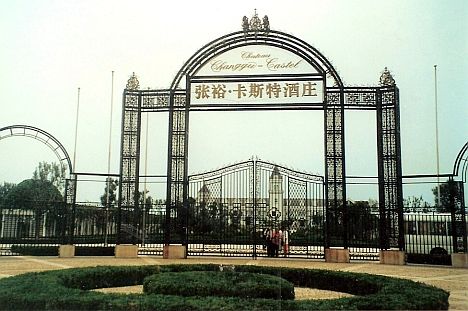 |
| Château Changyu-Castel in Yantai: main portal |
As always, not unlike in Europe, the personal impression is the decisive factor. For example, in the showroom of a winery in Yantai, on the Shandong peninsula. There, China's oldest winery -Changyu-,which means prosperity, documents its short history. We stop in front of four huge panels, incredulously amazed: under the title "World famous Châteaux" - "World famous wineries" - we meet old acquaintances, namely the Premiers of Bordeaux: Latour, Mouton, Margaux, Haut-Brion and Lafite. And, what else is there? The largest panel shows the sixth, world-famous château: Château Changyu-Castel. Have you heard of it? No, it's not in Bordelais, but here, in Yantai.
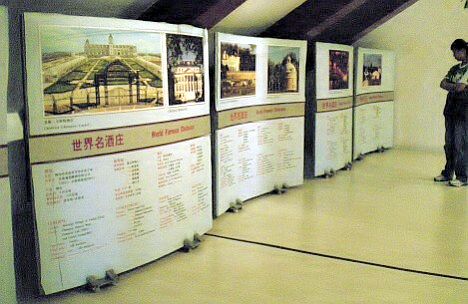 |
| The world's most famous wineries: exhibition at Château Changyu-Castel |
The situation reveals a lot about Chinese viticulture, where appearance and reality are so close. None of the seven wineries we visited wants to or can do without the most pompous representation possible. This is evident in the cellars, in the production facilities and in the castle-like buildings. They do not betray their pomp in Chinese architectural style. No, they are oriented towards European or American models. Bordeaux is the dominant ideal, in architectural style, but also in wine.
Château Changyu-Castel was built in close cooperation with the French beverage multinational Castel Frères. The French group - active in three areas: wine, beer and mineral water - is involved in the Chinese "Changyu Pioneer Wine Company" with a share of slightly less than 50%.
Five years ago, a magnificent château was inaugurated in Yantai, and this year the Chinese wine giant has already built another, even more magnificent château in Beijing: Château Changyu AFIP Global. From the opening speech: "A perfect platform for the international exchange of wine culture has been created here. Our society hopes that it will become a paradise for international wine lovers and a symbol of Chinese wine culture."
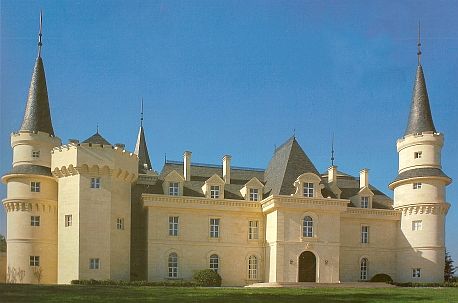 |
| Grand building in Beijing% Château Changyu AFIP. Meeting place for wine lovers from all over the world |
Indeed, all the wineries we visited reveal a similar self-image: "We are the greatest, we are the best, we are the only ones, we are." This message is - whenever possible - also made visible through presentation buildings.
Dragon Seal" is also planning a representative castle in the middle of the vineyards - outside Beijing. For the time being, it can only be admired as a model in the large exhibition room. But with the rapid development in China, the construction will probably not be long in coming.
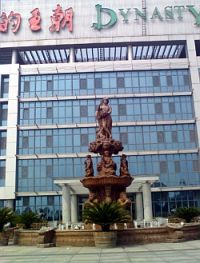 |
| Fountain at "Dynasty" headquarters with mythological figures |
We are in a similar situation at "Dynasty" in Tianjin, one of the market-leading wineries. For me, it is one of the most exciting companies in the Chinese wine industry. They started their first joint venture here in 1980. A state-of-the-art winery was built with the French cognac producer Rémy Martin. Today, the company is already largely independent - but still oriented towards France - and proud to possess probably the greatest experience in modern winemaking. The planned château looks suspiciously like the Châteaux Montesquieu and is to be built directly next to the current winery.
China's largest wine producer, Great Wall, with a market share of over 40%, is less oriented towards European models, but rather towards Australian or Californian ones. Accordingly, the representative buildings have less of a historical and more of a modern factory character. Only the wine cellar in Changli (Hebei Province), in one of the numerous production sites, is amazingly similar to the round cellar of Lafite-Rothschild in Pauillac.
The prestigious Domaine Franco-Chinois project is architecturally idiosyncratic, having been "founded to become a great winery, with an international reputation to boot". Here it is not so much a matter of selling wine quickly, but of "introducing the most modern viticultural techniques" with the help of the French wine industry, sponsored by the government. The vineyards, the architecture, the grape varieties, the technology, the equipment and the products represent the tradition of French viticulture and French science.
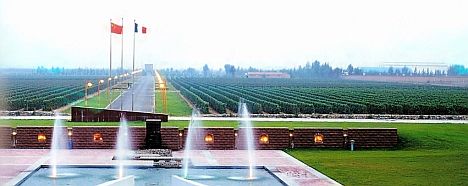 |
| Franco-Chinois model plantation% 22 hectares% 38 plots from farmers in the region |
The two best-known "exotics" among China's 400 or so wineries are foundations by foreign "exotics". Although quite different in nature, they adapt to the Chinese-European style, both in their wine production and in the splendour of their facilities.
The Austrian businessman Gernot Langes-Swarovski from the traditional Tyrolean glass dynasty is also involved in wine, not only in Argentina and Italy, but now also in China. A kilometre-long avenue of trees leads to the "Bodegas Langes" winery in Changli, where everything is a little bigger, more representative, more distinguished, more sophisticated and swankier. The winery includes a huge villa, the residence of the senior boss, who comes here to China about twice a year.
Classical music sprinkles the almost 200 hectares and accompanies the production in the super-modern cave, where the only method of production is the fall principle (without pumps). Yes, at Botega Langes everything is a little different: smoother, more elegant, more exclusive. This also includes the "Bio" label, which is awarded by the Chinese agricultural industry after thorough examination and a long waiting period. The architectural style, rather Argentine-Italian, the wines expensive and almost with a touch of the past K+K monarchy: neat, lush, flattering, graceful, trimmed to precious: "We want to produce the best wines in China," director Ren Jing, a top Chinese manager who previously worked in the car industry, told us.
That leaves another winery that was inspired and built by an innovative foreign maverick. By Englishman Michael Parry, a successful businessman from Hong Kong, who realised his "boyhood dream" in China in 1985, a large beautiful winery. Parry could not enjoy his dream for long, he died in 1991 at the age of 43. Today, the Qingdao beverage group (80%) and a Hong Kong company share the property. The glamour that Michael Parry brought to the winery in the nearby coastal city of Qingdao has remained: As a visitor, you get the feeling that the building style, the presentation and the quality of the wine are all in harmony here. Here, we were also looked after by the knowledgeable and informative head enologist, while at all the other wineries we were "only" received by the managers, marketers, export managers, coordinators, etc. They were able to tell us a lot, but only about the quality of the wine. They could tell us a lot, but almost nothing about their wines, except for a good hour at "Dragon Seal".
I have called this column "appearance and reality". Appearance, then, lies above all in the splendour of the wineries, in their hugely dimensioned facilities, in their show gardens and exhibition rooms, in their documentaries that show a lot, say little and reveal nothing.
And the being? These are the wines that are produced here. The often quoted statement: "quite, drinkable, smell indefinable, taste indefinable, no berries, no wood, no vanilla, maybe closest to liquorice not really that good", no longer applies. Being has also changed. There are still sweet and insipid cheap wines, but in China they are not cheap at all. There are those standard wines that often have a penetrating acetone tone and make drinking wine more than a little unpleasant.
 |
| Great Wall: One of the many production sites |
But there are also the Chinese top wines, which can always stand comparison with European wines, even with the wines of the rest of the "new world". Each of the more important wineries has at least one prestige wine. The price is surprising: from 100 to 400 euros is the rule. Only appearance? I have to disagree. These wines are really produced in China, these wines come from Chinese vines, these wines are the product of Chinese wine art (learned in a short time mainly from the French). At the moment, the many imported top wines from Europe are competing. Prestige wines. In China meant for appearances, to prove a new prosperity and wealth. Trademark of a certain stratum of the population, up to and including the upper middle class.
But it is quite possible that the internal prestige market will dry up in a short time, that expensive wines will be imported even more, that Chinese prestige products will no longer signal prosperity.
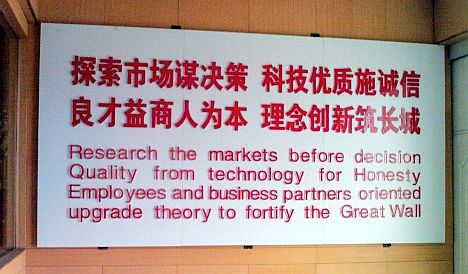 |
| Great Wall's motto: Future-oriented in the belief in global success |
Then - I am also convinced of this - the Chinese will export their own prestige wine to the whole world, as quality products, still clearly refined, adapted to the terroir, because the still young vines will then be older and the experience in winemaking even greater. Then appearances will finally become reality, and the utopia - today we drink something very special, a "top Chinese" - will become reality. I don't want to talk about the price pressure on the rest of the world's wine production. We already have experience in many other areas.
Sincerely
Yours sincerely
Peter (Züllig)
NB:
For once not so much a column, but a report, for all those who prefer facts and figures.